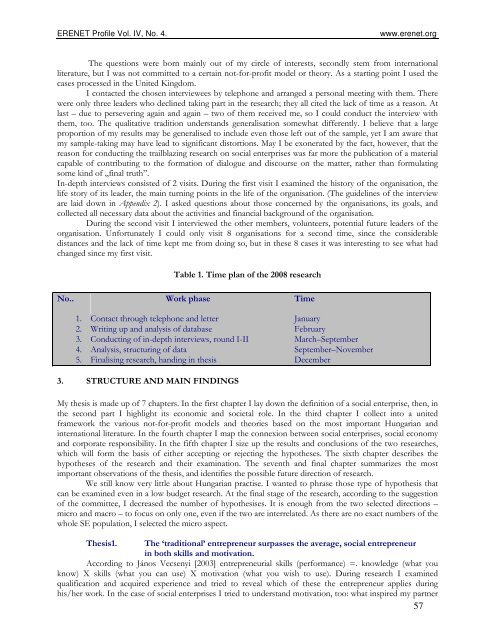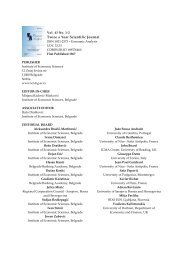Issue 16
Issue 16
Issue 16
Create successful ePaper yourself
Turn your PDF publications into a flip-book with our unique Google optimized e-Paper software.
ERENET Profile Vol. IV, No. 4.<br />
www.erenet.org<br />
The questions were born mainly out of my circle of interests, secondly stem from international<br />
literature, but I was not committed to a certain not-for-profit model or theory. As a starting point I used the<br />
cases processed in the United Kingdom.<br />
I contacted the chosen interviewees by telephone and arranged a personal meeting with them. There<br />
were only three leaders who declined taking part in the research; they all cited the lack of time as a reason. At<br />
last – due to persevering again and again – two of them received me, so I could conduct the interview with<br />
them, too. The qualitative tradition understands generalisation somewhat differently. I believe that a large<br />
proportion of my results may be generalised to include even those left out of the sample, yet I am aware that<br />
my sample-taking may have lead to significant distortions. May I be exonerated by the fact, however, that the<br />
reason for conducting the trailblazing research on social enterprises was far more the publication of a material<br />
capable of contributing to the formation of dialogue and discourse on the matter, rather than formulating<br />
some kind of „final truth”.<br />
In-depth interviews consisted of 2 visits. During the first visit I examined the history of the organisation, the<br />
life story of its leader, the main turning points in the life of the organisation. (The guidelines of the interview<br />
are laid down in Appendix 2). I asked questions about those concerned by the organisations, its goals, and<br />
collected all necessary data about the activities and financial background of the organisation.<br />
During the second visit I interviewed the other members, volunteers, potential future leaders of the<br />
organisation. Unfortunately I could only visit 8 organisations for a second time, since the considerable<br />
distances and the lack of time kept me from doing so, but in these 8 cases it was interesting to see what had<br />
changed since my first visit.<br />
Table 1. Time plan of the 2008 research<br />
No.. Work phase Time<br />
1. Contact through telephone and letter January<br />
2. Writing up and analysis of database February<br />
3. Conducting of in-depth interviews, round I-II March–September<br />
4. Analysis, structuring of data September–November<br />
5. Finalising research, handing in thesis December<br />
3. STRUCTURE AND MAIN FINDINGS<br />
My thesis is made up of 7 chapters. In the first chapter I lay down the definition of a social enterprise, then, in<br />
the second part I highlight its economic and societal role. In the third chapter I collect into a united<br />
framework the various not-for-profit models and theories based on the most important Hungarian and<br />
international literature. In the fourth chapter I map the connexion between social enterprises, social economy<br />
and corporate responsibility. In the fifth chapter I size up the results and conclusions of the two researches,<br />
which will form the basis of either accepting or rejecting the hypotheses. The sixth chapter describes the<br />
hypotheses of the research and their examination. The seventh and final chapter summarizes the most<br />
important observations of the thesis, and identifies the possible future direction of research.<br />
We still know very little about Hungarian practise. I wanted to phrase those type of hypothesis that<br />
can be examined even in a low budget research. At the final stage of the research, according to the suggestion<br />
of the committee, I decreased the number of hypothesises. It is enough from the two selected directions –<br />
micro and macro – to focus on only one, even if the two are interrelated. As there are no exact numbers of the<br />
whole SE population, I selected the micro aspect.<br />
Thesis1. The ‘traditional’ entrepreneur surpasses the average, social entrepreneur<br />
in both skills and motivation.<br />
According to János Vecsenyi [2003] entrepreneurial skills (performance) =. knowledge (what you<br />
know) X skills (what you can use) X motivation (what you wish to use). During research I examined<br />
qualification and acquired experience and tried to reveal which of these the entrepreneur applies during<br />
his/her work. In the case of social enterprises I tried to understand motivation, too: what inspired my partner<br />
57
















